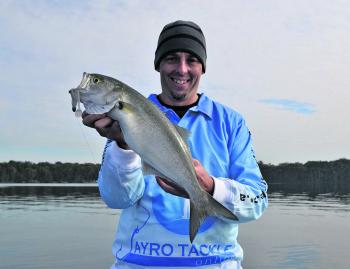Now is a beautiful time of year to spring into action. With a relatively wet winter behind us we now find ourselves heading towards spring for another year. Spring is a fantastic time of year to chase one of my favourite saltwater estuary fish – the humble dusky flathead.
There is no denying that this is a fish that is certainly readily available, and a great species for anglers to target on lures. They offer a lot of fun and a good feed at the end of the day but there is more to the unassuming flathead than meets the eye. Like most forms of fishing, anyone can go out and manage to get a particular species sooner or later if they try enough but if you want to consistently catch good-sized dusky flathead then you need to hone your skills and put in the effort to master this style of fishing.
I have fished for flathead on lures on and off for over 20 years now, and it is one form of fishing that I love more and more each season as I learn new tricks and techniques. In the past I could go out for a session and maybe score a few flathead on lures in the 40-50cm range and think I had a good trip, but after reading and researching all I could on the topic of chasing large flathead I have now been able to catch some solid fish on a fairly regular basis. Am I an expert on the topic? Certainly not, but I do continue to put countless hours into chasing these big estuary fish and I’m slowly getting things down pat. Hopefully after this article you too will be keen to get out and try your hand at scoring some real ‘croc-sized’ dusky flathead.
People will often say that flathead are an easy fish to catch or they are no fun because they don’t put up a fight. In the past I could see where these anglers were coming from, however after dedicating my angling experience over the past five years to chasing big flathead I can tell you how wrong those views are. The difference in finding, hooking and landing large dusky flathead compared to small to mid-range sized fish is something else. Flathead over 70cm really put on a much more spirited battle and fish over 80cm – well that’s a whole new level again. The sheer weight and power from these larger 80cm+ fish is just unreal and catching them on light spin outfits is a blast and a real challenge.
Flathead are a great fish for anglers to target for many reasons. The fact that they are so easily accessible is one reason. Basically any of the estuaries up or down the NSW coast has a good supply of flathead. The fact they love to nail lures is another very appealing factor of flathead fishing. The importance of catch and release practice is growing and I agree with looking after our fishery. However, there is nothing wrong with keeping some lovely fresh fish for the family, and flathead is a perfect fish for the table. It tastes great and it offers beautiful tailpieces that are totally free of bones, which makes them great for young children to eat. The best thing about flathead is there is usually enough of them around that you can pop a couple of 50cm fish in the esky for dinner then release the rest while you target that big girl. For myself, landing an 80cm+ flathead, taking some great pics and watching her swim away is about as good as it gets.
Flathead are basically around all year, but spring is one of the better times of the year for those anglers who really want to get that big girl. The water temperatures are still cold and the bait is still schooling deep so I generally spend most of my spring sessions targeting deeper water around 8-10m. I cannot emphasise how important the bait schools are. I always head to a few key spots that generally produce for me, but I have learnt over the years that after the first drift, if I’m not seeing signs of baitfish on the sounder then there is no use wasting time working this location and I’ll move on. The thing with these bait schools is that they are smashing up small whitebait and the like down deep and the flathead feed underneath on the scraps as they fall. This is a great sign for anglers chasing flathead.
If the deep waters aren’t working for me I’ll then target drop-offs as my second choice. I’m not saying you won’t get flathead in the shallows during cooler months, but I certainly do far better in deeper waters and the drop-offs from shallow to deep in cooler times of the year.
I only use 2500 size reels for this style of fishing. I find the reels have plenty of line capacity, enough grunt and remain light enough for me to hold and cast for long sessions. The number one must have for my reels is a smooth drag, and this is just as important with this style of fishing and this target species as with any other form of fishing. I like to spool my reels with 6-8lb braid and generally run a leader of 12-16lb fluorocarbon. As for rods, I like to use 6’10”–7’ rods in the 2-5kg range.
There is a wide range of lures that will catch flathead on our east coast estuaries. As a rule I use 4-6” soft plastics when I’m on the flathead hunt. Colour is critical when it comes to flathead fishing. Again I’m not saying that certain colours will never catch fish or that others will always, but it is a percentage game and if I’m investing my time and effort into chasing a big girl I want to use the tackle and lure offerings that will give me the best chance of achieving my target species. The reason I’m happy to persist with these lures for such a lengthy time, even without a hit is because I know they work and if the fish are there then these lures will produce. I love white and silver lures in particular. If I’m having no luck after a solid effort then I will often find one of two other options will do the trick – either an all pink or lime green plastic offering. If they still fail to produce, I’m going home for a coffee!
Jigheads are another key part of the puzzle. I love Impact Tackle jigheads. They offer a solid hook with a great shape for this style of fishing. I generally opt for a 3/8-1/2oz weight on a 4/0 hook. I often use heavier weights if need be, but it’s rare that I need to. One of the most useful pieces of equipment on my boat is a drift shoot (or sea anchor). I basically always deploy one when drifting for flathead as it slows my drift perfectly and allows me to offer lighter weighted jigheads and fish effectively on the bottom for longer periods of time.
Another key thing to consider when chasing larger trophy flathead, is to invest in some scent. I am a real believer in the use of scents – I don’t think that using scent will get you a bite but I believe that it gives you a second, third and sometimes even a fourth bite at the cherry if the fish has trouble finding the hook. I cannot tell you how many times I have hooked a flathead only to have it shake itself free within the first few moments. The key here is to open the bail arm and get the plastic straight back down. I assure you that without scent 9/10 times the fish will not go for a second bite, but with scent they just can’t resist. Whatever brand you prefer should work fine and personally we do very well using Sax scent and Pro Lure scent, but I’m sure others work just as well.
The by-catch on offer is impressive, to say the least. Every year we come across some fantastic estuary mulloway as by-catch while targeting flathead. You often find the hit from mulloway comes mid-water either as the lure is falling or on the retrieve. They don’t hug the bottom, instead they actively feed mid-water on chopper tailor bait balls. Mulloway are certainly the holy grail of estuary species and once you land one you will see why!
I cannot explain how addictive it is to chase large flathead in our estuaries on soft plastics. Believe me, once you land that first solid croc at over 80cm you will have a new appreciation for the humble dusky flathead and its fighting abilities. I know how tempting it is at the start to want to keep these big fish and brag to your mates, but they are certainly the ones to release. They are female breeders, and are much more valuable back in the water doing their thing. After all, they don’t taste great when they get that large anyway. Give her a kiss, take a pic and send her on her way. It’s a hard feeling to beat.
Reads: 3772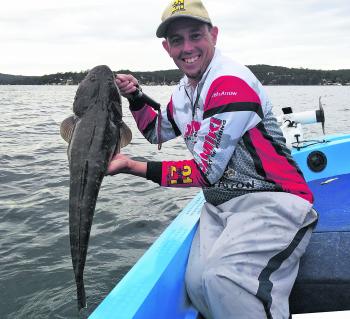
The author’s best flathead to date. At just over 85cm, this big girl fell for a soft plastic in white.
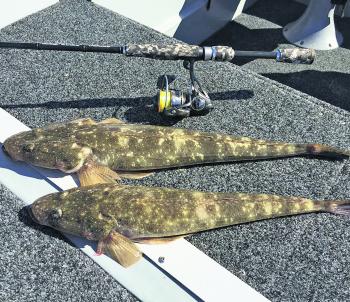
A recent hot session in the deep enabled the author to keep a few mid-size fish for the table.
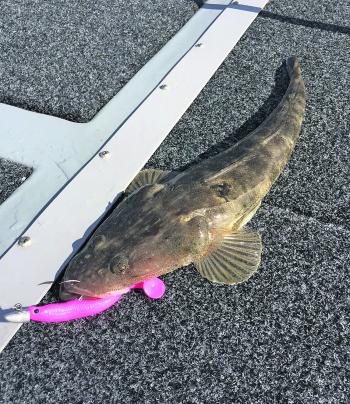
Not his go-to lure but certainly the pink plastics have their place in the author’s tackle tray.
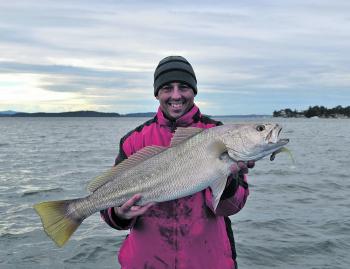
A solid mulloway is always a welcome by-catch when targeting large estuary flathead.
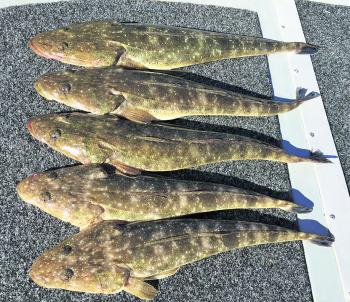
It is easy to get good numbers of mid-sized fish. Just remember you only need a few for a feed and the rest can go back after the picture for your next trip.

